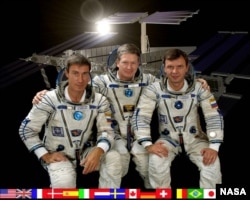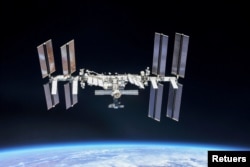A new study has found that areas of the brain containing fluid expand when astronauts are on space missions for six months or longer. The American space agency NASA funded the study.
The brain areas are called cerebral ventricles. They contain cerebrospinal fluid, a clear and watery liquid that flows in and around the brain and spinal cord. The fluid helps protect the brain against sudden impact. The fluid also removes waste products.
Researchers based their research on brain scans of 30 astronauts. They found that it took three years for the ventricles to fully return to normal size after long space missions. The results mean that astronauts may need to wait at least three years between longer space missions.
Heather McGregor is a University of Florida brain scientist. She was the lead writer of the study, which appeared in the publication Scientific Reports. She told the Reuters news agency that if the ventricles do not have enough time to get back to normal size, they could have less space to expand on a following trip to space. This could affect the brain’s ability to deal with the changes in gravity that astronauts face.
Rachael Seidler is a University of Florida professor of applied physiology and kinesiology. She was also a writer of the study. She said, “the impact of ventricular expansion is currently not known,” and that scientists need to do more studies on the subject.
She added that the expansion likely compresses the area of the brain around the spaces. To compress means to press, squeeze or make smaller.
On Earth, valves in the body’s vascular system prevent fluid from staying at our feet due to gravity. But in space, without gravity, the valves push the fluid more towards the head. Seidler said this is what likely causes the ventricular expansion. As a result, the brain sits higher in the skull.
The study involved 23 male and seven female astronauts from the U.S., Canadian and European space agencies. The average age of the astronauts was 47. Eight of the astronauts traveled on space shuttle missions that lasted about two weeks. Eighteen were on International Space Station (ISS) missions of about six months. The other four took part in ISS missions that lasted about a year.
The astronauts who went on short missions experienced little or no ventricular size change. A size increase occurred in astronauts after missions of six months or longer. There was no difference in those who went on missions for six months compared to those who went on year-long missions.
The fact that enlargement did not worsen after six months could be good news for future Mars missions. Astronauts may spend two years in microgravity during trips to Mars. The study results are also good news for people thinking about going on short space tourism flights, Seidler added.
Low gravity causes other changes in the human body, as well. These include decreases in bone and muscle mass, some changes to the heart and lung system, and issues with the balance system in the inner ear.
Longer space missions might also increase cancer risk because of greater exposure to solar radiation.
I’m Andrew Smith.
Will Dunham wrote this story for Reuters. Andrew Smith adapted it for VOA Learning English.
___________________________________________________________________
Words in This Story
fund -v. to pay for or provide some money for some activity or project
impact -n. a) the action of one object hitting another, or the force with which one object hits another. ; b) the strong effect something has on another thing or person.
physiology -n. the scientific study of how people's and animals' bodies function
kinesiology -n. the scientific study of how people's and animals' bodies move
occur -v. to happen
exposure -n. placement in a situation where dangerous or damaging things can affect you
_______________________________________________________________________
We want to hear from you.
We have a new comment system. Here is how it works:
- Write your comment in the box.
- Under the box, you can see four images for social media accounts. They are for Disqus, Facebook, Twitter and Google.
- Click on one image and a box appears. Enter the login for your social media account. Or you may create one on the Disqus system. It is the blue circle with “D” on it. It is free.
Each time you return to comment on the Learning English site, you can use your account and see your comments and replies to them. Our comment policy is here.












Forum